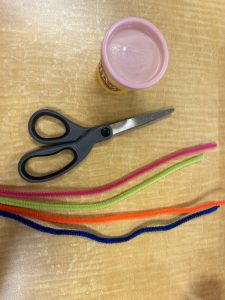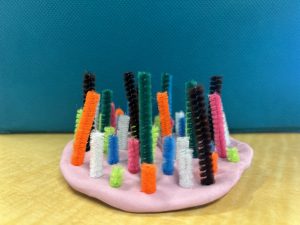26 Tiny Helpers: Instructor guide
Madelynn Brown; Snow Li; and Micaela Sanchez Cereceda
Lesson title
Tiny Helpers: Microvilli in the Tummy!
Instructional Guide
The learners will be able to list the basic functions of the microvilli and where they reside within the body. The lesson will include a short story describing a day in the life of the microvilli, including its daily functions, activities, and location. The learners will also understand the basic structure of the microvilli. Students will create the microvilli out of Play-Doh and pipe cleaners. The students will then show their microvilli structures to the class to assess their understanding of the material learned.
Intended Grade Level
The intended grade level for this lesson is kindergarten. Prior to starting the lesson, the students should understand that food consumed is digested in the tummy.
Learning objectives
- Students will understand the basic role of the GI system in breaking down food.
- Students will know where the microvilli are located within the GI tract.
- Students will be able to explain the basic functions of the microvilli.
Lesson Format
The lesson will take 35-60 minutes to complete and can be done with any size group. Students will be working both in pairs and in a large group. Materials needed include Play-Doh, pipe cleaners, and access to the narrarated book, “Mike the Mighty Microvilli”.
- Start the lesson by asking the entire class “Have you ever seen a dog eats its breakfast? What do you think happens to it inside its tummy?” (3 mins)
- Next, show the class the narrated book, “Mike the Mighty Microvilli”. (2 mins)
- After showing the book, re-ask the question “What do you think happens to the breakfast inside the dogs tummy?”. Wrap up the question with discussing the microvilli aiding in digestion. (5 mins)
- Next, have the class split up into groups of two. Hand out the Play-Doh and pipe cleaners to the groups, and have them work on building the microvilli together. (15 mins)
- Once the students have completed their microvilli sculptures, go around in a circle having each student share their creation. (10 mins)
- Further exploration: play the Magic School Bus episode 10 – “For Lunch”. Link to episode: https://www.youtube.com/watch?v=ug5nVzkK3EI (25 mins)
Lesson Background
The microvilli are finger-like projections that are present on cells that line the gastrointestinal tract. The microvilli are responsible for aiding in digestion by increasing the absorptive surface area.
Composition
Microvilli are composted from a core of actin filaments that are bundled together in groups of 20-30 per microvillus. The bundle of filaments are held together by proteins. The base of the microvilli is the plasma membrane that runs along the cell surface.
Location
The microvilli heavily populate the small intestine of the gastrointestinal tract. This is because most of the food absorption occurs in the small intestine. As absorption activity decreases moving toward the large intestine, there will be less and less microvilli present.
The most common spot to find microvilli within the small intestine will be on absorptive cells called enterocytes. Microvilli make up the surface of the enterocytes. Due to the finger-like projections of the microvilli, they increase the surface area of the enterocytes, allowing them to absorb more nutrients.
Function
The main function of microvilli is to increase surface area and to increase absorption. Aside from absorption, they also have enzymatic activity due to glycocalyx which resides on top of the microvilli. Together, the microvilli and the glycocalyx coating creates a brush border of enzymes that break down complex molecules into smaller/more digestible molecules. Additionally, the microvilli can house nutrients and aid in their transportation into the bloodstream or lymphatic system. Lastly, the microvilli play a protective role as they protect the cell membrane from injury.
Damage
Microvilli can be damaged due to infection, disease, and toxins. Damaged to the microvilli will lead to malabsorption.
Activities
Activity 1
Show the students the narrated book, “Mike the Mighty Microvilli”. Prior to showing the book, ask the students “Have you ever seen a dog eat its breakfast? What do you think happens to it inside its tummy?”. After the story, re-ask the question to see if their answer changed. Wrap up the question with discussing how the microvilli help digest the dog’s breakfast.
Activity 2
Have the class get into groups of two. Hand out the supplies to each group, and instruct them to work together and build what they think the microvilli look inside the dog’s small intestine.
Supplies needed: scissors, Play-Doh, and pipe cleaners

Example of microvilli activity:

Wrap up the activity by going around in a circle and having each group describe and show their microvilli structure.
Common misconceptions and challenge points
Students may be curious if they have microvilli too. Yes we do! Humans also have microvilli that aid in digestion that are housed within the digestive tract. Another misconception that may need to be made clear is that microvilli are not their own cell, instead they are a part of the cell’s surface.
Assessment
The students will have their knowledge assessed at the end up activity 2 when they are describing their microvilli structures.
Further exploration
Play episode 10 of the Magic School Bus – “For Lunch”. This video will help the students get a deeper understanding of how food is digested. The students should try to point out the microvilli seen within the digestive tract. Link to episode: https://www.youtube.com/watch?v=ug5nVzkK3EI
Other chapters within this textbook may be interesting for students. Some options can be found linked below:

